
The University of the State of New York
REGENTS HIGH SCHOOL EXAMINATION
GEOMETRY
Tuesday, January 23, 2018 — 9:15 a.m. to 12:15 p.m.
MODEL RESPONSE SET
Table of Contents
Question 25 . . . . . . . . . . . . . . . . . . . 2
Question 26 . . . . . . . . . . . . . . . . . . . 8
Question 27 . . . . . . . . . . . . . . . . . . 13
Question 28 . . . . . . . . . . . . . . . . . . 19
Question 29 . . . . . . . . . . . . . . . . . . 23
Question 30 . . . . . . . . . . . . . . . . . . 27
Question 31 . . . . . . . . . . . . . . . . . . 33
Question 32 . . . . . . . . . . . . . . . . . . 37
Question 33 . . . . . . . . . . . . . . . . . . 43
Question 34 . . . . . . . . . . . . . . . . . . 49
Question 35 . . . . . . . . . . . . . . . . . . 57

Question 25
Score 2: The student gave a complete and correct response.
Geometry – Jan. ’18 [2]
25 Given: Parallelogram ABCD with diagonal drawn
Prove: ABC ⬵ CDA
AD
BC
AC

Question 25
Score 2: The student gave a complete and correct response.
Geometry – Jan. ’18 [3]
25 Given: Parallelogram ABCD with diagonal drawn
Prove: ABC ⬵ CDA
AD
BC
AC

Question 25
Score 1: The student wrote a proof that demonstrates a good understanding of the method of
proof, but some statements and/or reasons are missing or incorrect.
Geometry – Jan. ’18 [4]
25 Given: Parallelogram ABCD with diagonal drawn
Prove: ABC ⬵ CDA
AD
BC
AC

Question 25
Score 1: The student did not state a correct reason of congruency in step 6.
Geometry – Jan. ’18 [5]
25 Given: Parallelogram ABCD with diagonal drawn
Prove: ABC ⬵ CDA
AD
BC
AC

Question 25
Score 0: The student did not state enough correct relevant statements and/or reasons to conclude
the triangles are congruent by SAS.
Geometry – Jan. ’18 [6]
25 Given: Parallelogram ABCD with diagonal drawn
Prove: ABC ⬵ CDA
AD
BC
AC

Question 25
Score 0: The student did not show enough correct relevant work to receive any credit.
Geometry – Jan. ’18 [7]
25 Given: Parallelogram ABCD with diagonal drawn
Prove: ABC ⬵ CDA
AD
BC
AC

Geometry – Jan. ’18 [8]
Question 26
Score 2: The student gave a complete and correct response.
26 The diagram below shows circle O with diameter . Using a compass and straightedge,
construct a square that is inscribed in circle O. [Leave all construction marks.]
O
AB
AB

Geometry – Jan. ’18 [9]
Question 26
Score 2: The student gave a complete and correct response.
26 The diagram below shows circle O with diameter . Using a compass and straightedge,
construct a square that is inscribed in circle O. [Leave all construction marks.]
O
AB
AB

Geometry – Jan. ’18 [10]
Question 26
Score 1: The student drew an appropriate construction, but drew the square incorrectly.
26 The diagram below shows circle O with diameter . Using a compass and straightedge,
construct a square that is inscribed in circle O. [Leave all construction marks.]
O
AB
AB

Geometry – Jan. ’18 [11]
Question 26
Score 1: The student drew an appropriate construction, but did not draw the square.
26 The diagram below shows circle O with diameter . Using a compass and straightedge,
construct a square that is inscribed in circle O. [Leave all construction marks.]
O
AB
AB

Geometry – Jan. ’18 [12]
Question 26
Score 0: The student had a completely incorrect response.
26 The diagram below shows circle O with diameter . Using a compass and straightedge,
construct a square that is inscribed in circle O. [Leave all construction marks.]
O
AB
AB

Geometry – Jan. ’18 [13]
Question 27
Score 2: The student gave a complete and correct response.
27 Given: Right triangle ABC with right angle at C
If sin A increases, does cos B increase or decrease? Explain why.

Geometry – Jan. ’18 [14]
Question 27
Score 2: The student gave a complete and correct response.
27 Given: Right triangle ABC with right angle at C
If sin A increases, does cos B increase or decrease? Explain why.

Geometry – Jan. ’18 [15]
Question 27
Score 1: The student wrote a partially correct explanation.
27 Given: Right triangle ABC with right angle at C
If sin A increases, does cos B increase or decrease? Explain why.

Geometry – Jan. ’18 [16]
Question 27
Score 1: The student wrote an incomplete explanation.
27 Given: Right triangle ABC with right angle at C
If sin A increases, does cos B increase or decrease? Explain why.

Geometry – Jan. ’18 [17]
Question 27
Score 0: The student wrote increases, but no explanation was written.
27 Given: Right triangle ABC with right angle at C
If sin A increases, does cos B increase or decrease? Explain why.

Geometry – Jan. ’18 [18]
Question 27
Score 0: The student had a completely incorrect response.
27 Given: Right triangle ABC with right angle at C
If sin A increases, does cos B increase or decrease? Explain why.
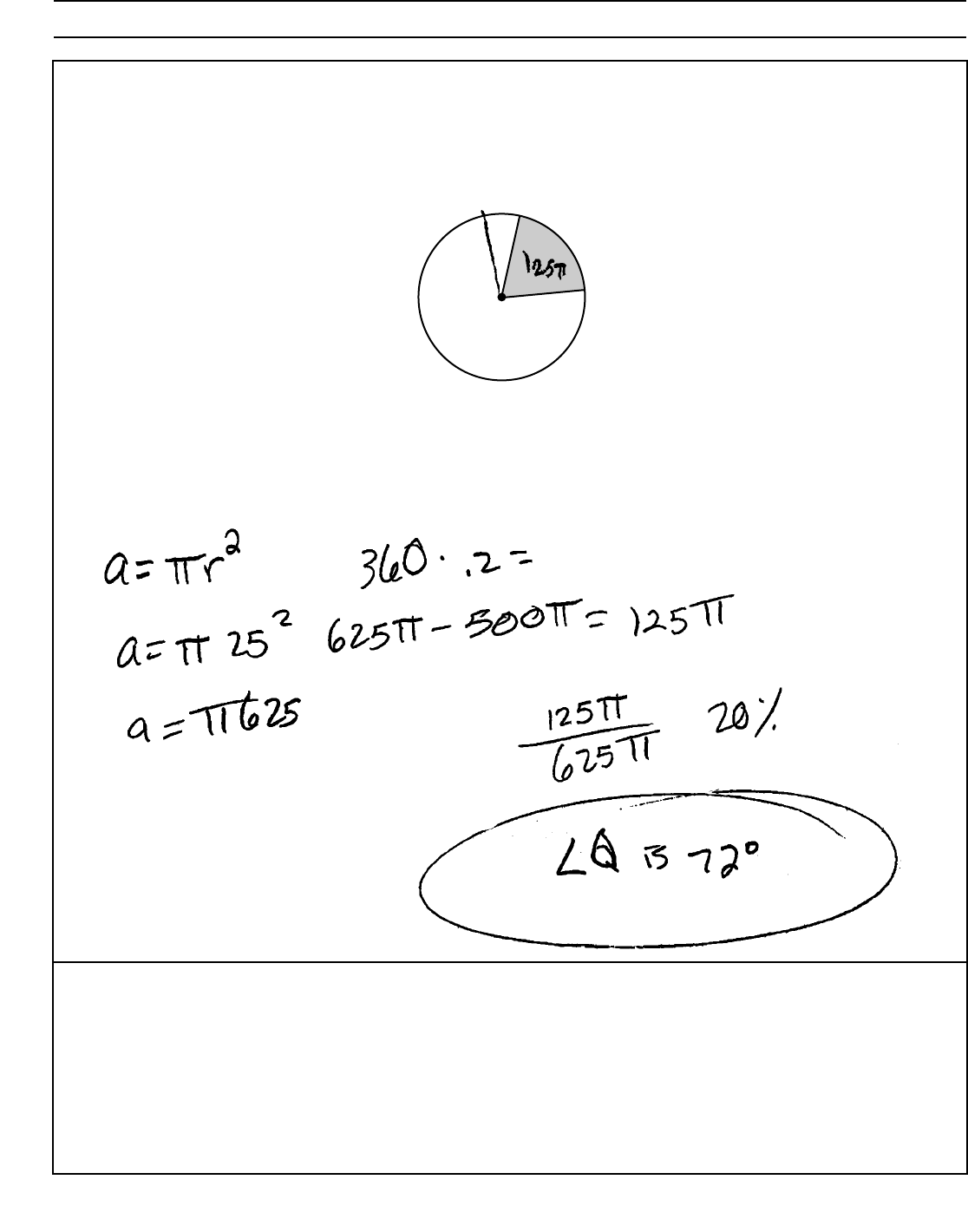
Geometry – Jan. ’18 [19]
Question 28
Score 2: The student gave a complete and correct response.
28 In the diagram below, the circle has a radius of 25 inches. The area of the unshaded sector
is 500π in
2
.
Q
25 in

Geometry – Jan. ’18 [20]
Question 28
Score 1: The student calculated the measure of the central angle for the unshaded region.
28 In the diagram below, the circle has a radius of 25 inches. The area of the unshaded sector
is 500π in
2
.
Q
25 in

Geometry – Jan. ’18 [21]
Question 28
Score 1: The student wrote the measure of the central angle in radian measure.
28 In the diagram below, the circle has a radius of 25 inches. The area of the unshaded sector
is 500π in
2
.
Q
25 in

Geometry – Jan. ’18 [22]
Question 28
Score 0: The student did not show enough correct relevant work to receive any credit.
28 In the diagram below, the circle has a radius of 25 inches. The area of the unshaded sector
is 500π in
2
.
Q
25 in

Geometry – Jan. ’18 [23]
Question 29
Score 2: The student gave a complete and correct response.
29 A machinist creates a solid steel part for a wind turbine engine. The part has a volume of
1015 cubic centimeters. Steel can be purchased for $0.29 per kilogram, and has a density of
7.95 g/cm
3
.
If the machinist makes 500 of these parts, what is the cost of the steel, to the nearest dollar?

Geometry – Jan. ’18 [24]
Question 29
Score 2: The student gave a complete and correct response.
29 A machinist creates a solid steel part for a wind turbine engine. The part has a volume of
1015 cubic centimeters. Steel can be purchased for $0.29 per kilogram, and has a density of
7.95 g/cm
3
.
If the machinist makes 500 of these parts, what is the cost of the steel, to the nearest dollar?

Geometry – Jan. ’18 [25]
Question 29
Score 1: The student did not correctly convert from grams to kilograms.
29 A machinist creates a solid steel part for a wind turbine engine. The part has a volume of
1015 cubic centimeters. Steel can be purchased for $0.29 per kilogram, and has a density of
7.95 g/cm
3
.
If the machinist makes 500 of these parts, what is the cost of the steel, to the nearest dollar?

Geometry – Jan. ’18 [26]
Question 29
Score 0: The student did not convert from grams to kilograms and divided by the density instead
of multiplying.
29 A machinist creates a solid steel part for a wind turbine engine. The part has a volume of
1015 cubic centimeters. Steel can be purchased for $0.29 per kilogram, and has a density of
7.95 g/cm
3
.
If the machinist makes 500 of these parts, what is the cost of the steel, to the nearest dollar?

Geometry – Jan. ’18 [27]
Question 30
Score 2: The student gave a complete and correct response.
30 In the graph below, ABC has coordinates A(⫺9,2), B(⫺6,⫺6), and C(⫺3,⫺2), and RST has
coordinates R(⫺2,9), S(5,6), and T(2,3).
Is ABC congruent to RST? Use the properties of rigid motions to explain your reasoning.
y
x
C
A
B
R
T
S

Geometry – Jan. ’18 [28]
Question 30
Score 2: The student gave a complete and correct response.
30 In the graph below, ABC has coordinates A(⫺9,2), B(⫺6,⫺6), and C(⫺3,⫺2), and RST has
coordinates R(⫺2,9), S(5,6), and T(2,3).
Is ABC congruent to RST? Use the properties of rigid motions to explain your reasoning.
y
x
C
A
B
R
T
S

Geometry – Jan. ’18 [29]
Question 30
Score 1: The student wrote an incomplete explanation by not using the properties of rigid
motions.
30 In the graph below, ABC has coordinates A(⫺9,2), B(⫺6,⫺6), and C(⫺3,⫺2), and RST has
coordinates R(⫺2,9), S(5,6), and T(2,3).
Is ABC congruent to RST? Use the properties of rigid motions to explain your reasoning.
y
x
C
A
B
R
T
S

Geometry – Jan. ’18 [30]
Question 30
Score 1: The student wrote an incomplete explanation by not using the properties of rigid
motions.
30 In the graph below, ABC has coordinates A(⫺9,2), B(⫺6,⫺6), and C(⫺3,⫺2), and RST has
coordinates R(⫺2,9), S(5,6), and T(2,3).
Is ABC congruent to RST? Use the properties of rigid motions to explain your reasoning.
y
x
C
A
B
R
T
S

Geometry – Jan. ’18 [31]
Question 30
Score 0: The student had a completely incorrect response. Preserving slope is not a property of
rigid motions.
30 In the graph below, ABC has coordinates A(⫺9,2), B(⫺6,⫺6), and C(⫺3,⫺2), and RST has
coordinates R(⫺2,9), S(5,6), and T(2,3).
Is ABC congruent to RST? Use the properties of rigid motions to explain your reasoning.
y
x
C
A
B
R
T
S

Geometry – Jan. ’18 [32]
Question 30
Score 0: The student did not write an explanation.
30 In the graph below, ABC has coordinates A(⫺9,2), B(⫺6,⫺6), and C(⫺3,⫺2), and RST has
coordinates R(⫺2,9), S(5,6), and T(2,3).
Is ABC congruent to RST? Use the properties of rigid motions to explain your reasoning.
y
x
C
A
B
R
T
S

Geometry – Jan. ’18 [33]
Question 31
Score 2: The student gave a complete and correct response.
31 Bob places an 18-foot ladder 6 feet from the base of his house and leans it up against the side of
his house. Find, to the nearest degree, the measure of the angle the bottom of the ladder makes
with the ground.

Geometry – Jan. ’18 [34]
Question 31
Score 1: The student wrote an incorrect trigonometric equation, but solved the equation
correctly.
31 Bob places an 18-foot ladder 6 feet from the base of his house and leans it up against the side of
his house. Find, to the nearest degree, the measure of the angle the bottom of the ladder makes
with the ground.

Geometry – Jan. ’18 [35]
Question 31
Score 1: The student wrote a correct trigonometric equation, but no further correct work was
shown.
31 Bob places an 18-foot ladder 6 feet from the base of his house and leans it up against the side of
his house. Find, to the nearest degree, the measure of the angle the bottom of the ladder makes
with the ground.

Geometry – Jan. ’18 [36]
Question 31
Score 0: The student had a completely incorrect response.
31 Bob places an 18-foot ladder 6 feet from the base of his house and leans it up against the side of
his house. Find, to the nearest degree, the measure of the angle the bottom of the ladder makes
with the ground.

Geometry – Jan. ’18 [37]
Question 32
Score 4: The student gave a complete and correct response.
32 Triangle ABC and triangle ADE are graphed on the set of axes below.
Describe a transformation that maps triangle ABC onto triangle ADE.
Explain why this transformation makes triangle ADE similar to triangle ABC.
D
x
y
E
C
A
B

Geometry – Jan. ’18 [38]
Question 32
Score 3: The student made an incorrect statement that figures are proportional.
32 Triangle ABC and triangle ADE are graphed on the set of axes below.
Describe a transformation that maps triangle ABC onto triangle ADE.
Explain why this transformation makes triangle ADE similar to triangle ABC.
D
x
y
E
C
A
B

Geometry – Jan. ’18 [39]
Question 32
Score 2: The student did not identify the center of dilation and the scale factor. The student did not
provide a complete explanation connecting the transformation and the similarity.
32 Triangle ABC and triangle ADE are graphed on the set of axes below.
Describe a transformation that maps triangle ABC onto triangle ADE.
Explain why this transformation makes triangle ADE similar to triangle ABC.
D
x
y
E
C
A
B

Geometry – Jan. ’18 [40]
Question 32
Score 1: The student wrote an incomplete description of the dilation by not stating the center of
dilation. No further correct work was shown.
32 Triangle ABC and triangle ADE are graphed on the set of axes below.
Describe a transformation that maps triangle ABC onto triangle ADE.
Explain why this transformation makes triangle ADE similar to triangle ABC.
D
x
y
E
C
A
B

Geometry – Jan. ’18 [41]
Question 32
Score 1: The student did not describe the transformation. The student did not provide a complete
explanation.
32 Triangle ABC and triangle ADE are graphed on the set of axes below.
Describe a transformation that maps triangle ABC onto triangle ADE.
Explain why this transformation makes triangle ADE similar to triangle ABC.
D
x
y
E
C
A
B
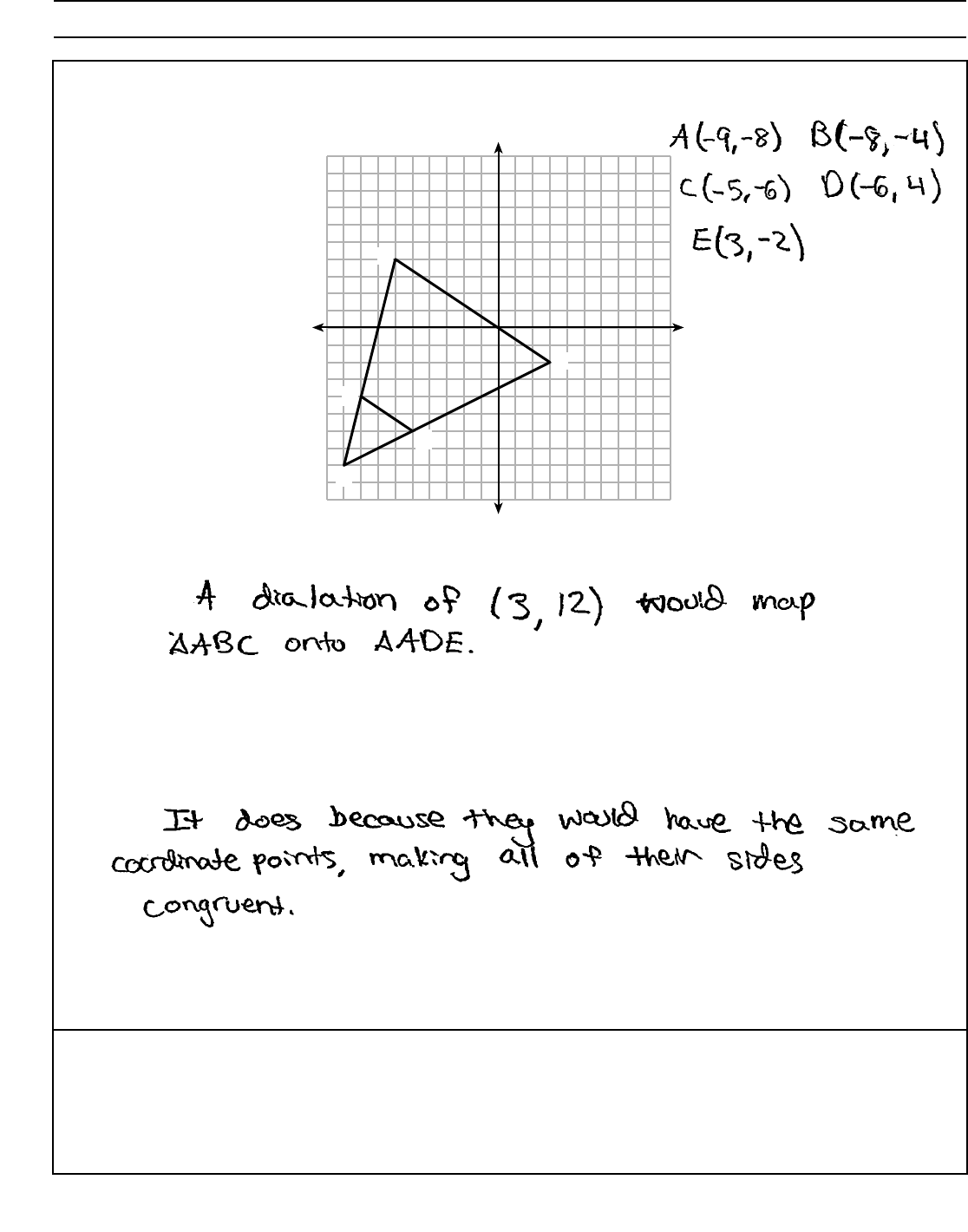
Geometry – Jan. ’18 [42]
Question 32
Score 0: The student had a completely incorrect response.
32 Triangle ABC and triangle ADE are graphed on the set of axes below.
Describe a transformation that maps triangle ABC onto triangle ADE.
Explain why this transformation makes triangle ADE similar to triangle ABC.
D
x
y
E
C
A
B
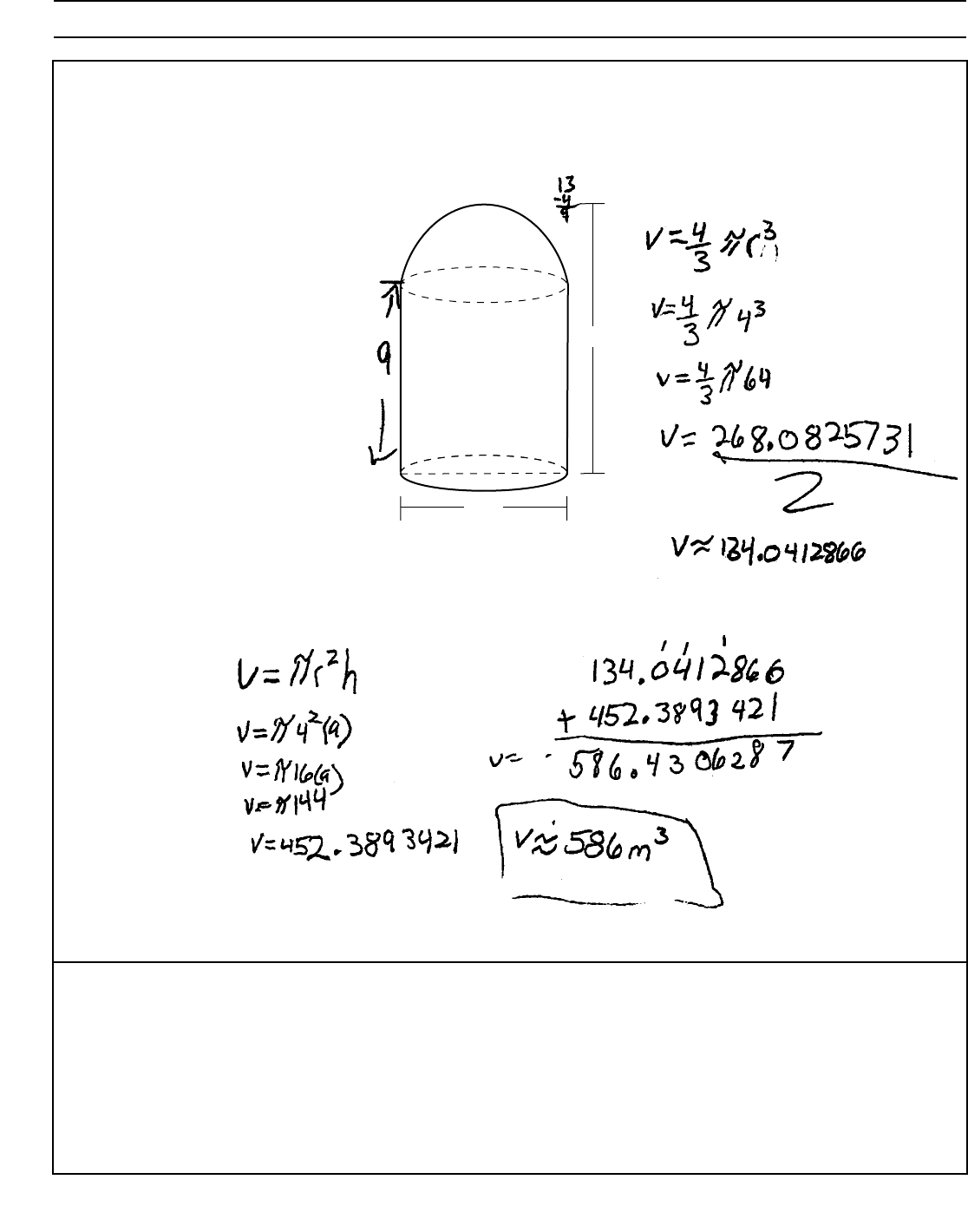
Geometry – Jan. ’18 [43]
Question 33
Score 4: The student gave a complete and correct response.
33 A storage tank is in the shape of a cylinder with a hemisphere on the top. The highest point on the
inside of the storage tank is 13 meters above the floor of the storage tank, and the diameter inside
the storage tank.
13 m
8 m

Geometry – Jan. ’18 [44]
Question 33
Score 3: The student used 13 instead of 9 for the height of the cylinder.
33 A storage tank is in the shape of a cylinder with a hemisphere on the top. The highest point on the
inside of the storage tank is 13 meters above the floor of the storage tank, and the diameter inside
the storage tank.
13 m
8 m

Geometry – Jan. ’18 [45]
Question 33
Score 2: The student made one computational error in determining the radius and one rounding
error.
33 A storage tank is in the shape of a cylinder with a hemisphere on the top. The highest point on the
inside of the storage tank is 13 meters above the floor of the storage tank, and the diameter inside
the storage tank.
13 m
8 m
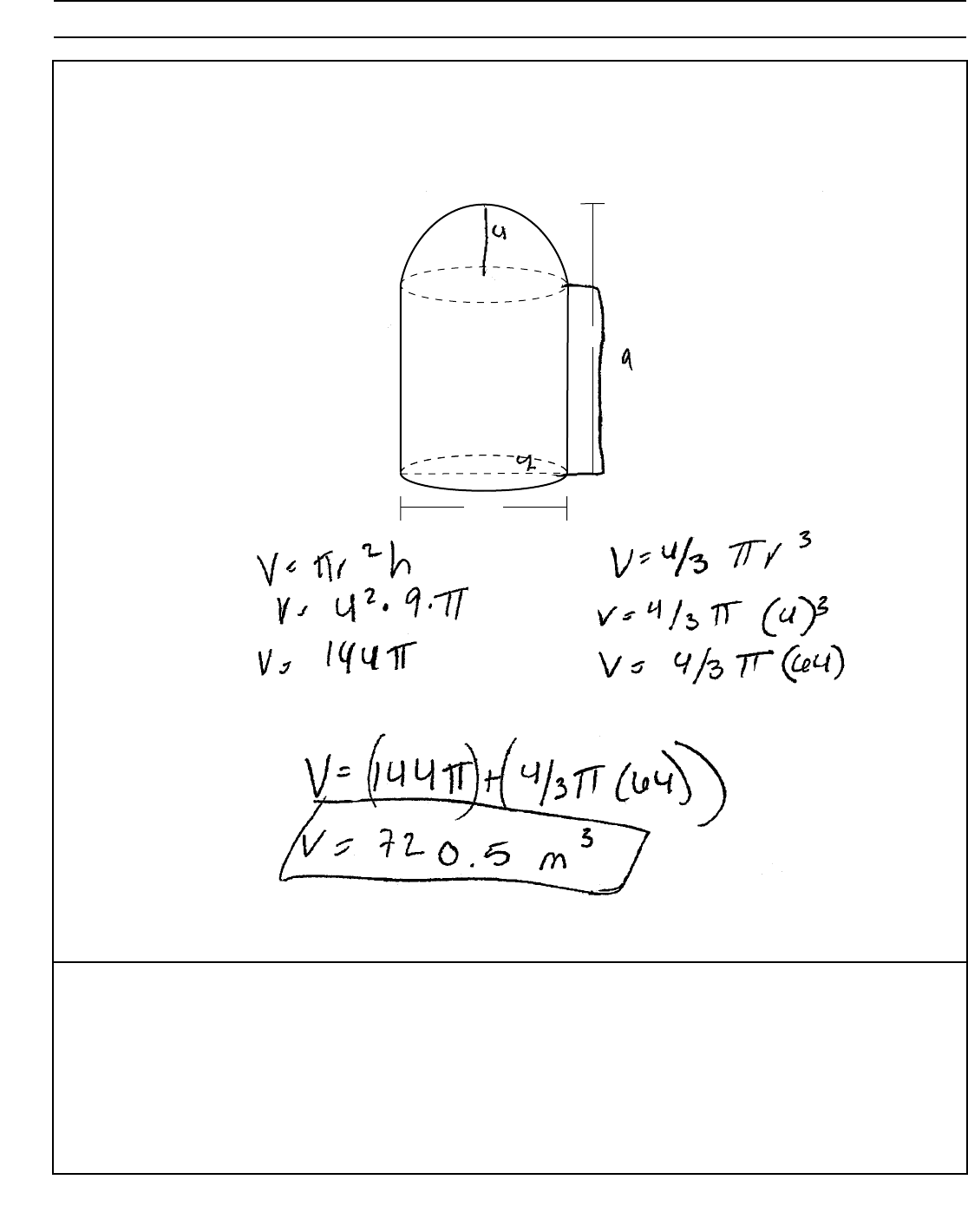
Geometry – Jan. ’18 [46]
Question 33
Score 2: The student did not divide the volume of a sphere by two and then rounded incorrectly.
33 A storage tank is in the shape of a cylinder with a hemisphere on the top. The highest point on the
inside of the storage tank is 13 meters above the floor of the storage tank, and the diameter inside
the storage tank.
13 m
8 m

Geometry – Jan. ’18 [47]
Question 33
Score 1: The student made one conceptual error by assuming the entire tank is a cylinder and
made one rounding error.
33 A storage tank is in the shape of a cylinder with a hemisphere on the top. The highest point on the
inside of the storage tank is 13 meters above the floor of the storage tank, and the diameter inside
the storage tank.
13 m
8 m

Geometry – Jan. ’18 [48]
Question 33
Score 0: The student had a completely incorrect response.
33 A storage tank is in the shape of a cylinder with a hemisphere on the top. The highest point on the
inside of the storage tank is 13 meters above the floor of the storage tank, and the diameter inside
the storage tank.
13 m
8 m

Geometry – Jan. ’18 [49]
Question 34
Score 4: The student gave a complete and correct response.
34 As shown in the diagram below, an island (I) is due north of a marina (M). A boat house (H) is
4.5 miles due west of the marina. From the boat house, the island is located at an angle of 54° from
the marina.
Determine and state, to the nearest tenth of a mile, the distance from the boat house (H) to the
island (I).
M
I
H 4.5 m
marina (M).
4.5 miles

Geometry – Jan. ’18 [50]
Question 34
Score 4: The student gave a complete and correct response.
34 As shown in the diagram below, an island (I) is due north of a marina (M). A boat house (H) is
4.5 miles due west of the marina. From the boat house, the island is located at an angle of 54° from
the marina.
M
I
H 4.5 m
marina (M).
4.5 miles
Determine and state, to the nearest tenth of a mile, the distance from the boat house (H) to the
island (I).

Geometry – Jan. ’18 [51]
Question 34
Score 3: The student made a computational error in finding IM.
34 As shown in the diagram below, an island (I) is due north of a marina (M). A boat house (H) is
4.5 miles due west of the marina. From the boat house, the island is located at an angle of 54° from
the marina.
Determine and state, to the nearest tenth of a mile, the distance from the boat house (H) to the
island (I).
M
I
H 4.5 m
marina (M).
4.5 miles

Geometry – Jan. ’18 [52]
Question 34
Score 3: The student showed no work to determine IM.
34 As shown in the diagram below, an island (I) is due north of a marina (M). A boat house (H) is
4.5 miles due west of the marina. From the boat house, the island is located at an angle of 54° from
the marina.
Determine and state, to the nearest tenth of a mile, the distance from the boat house (H) to the
island (I).
M
I
H 4.5 m
marina (M).
4.5 miles
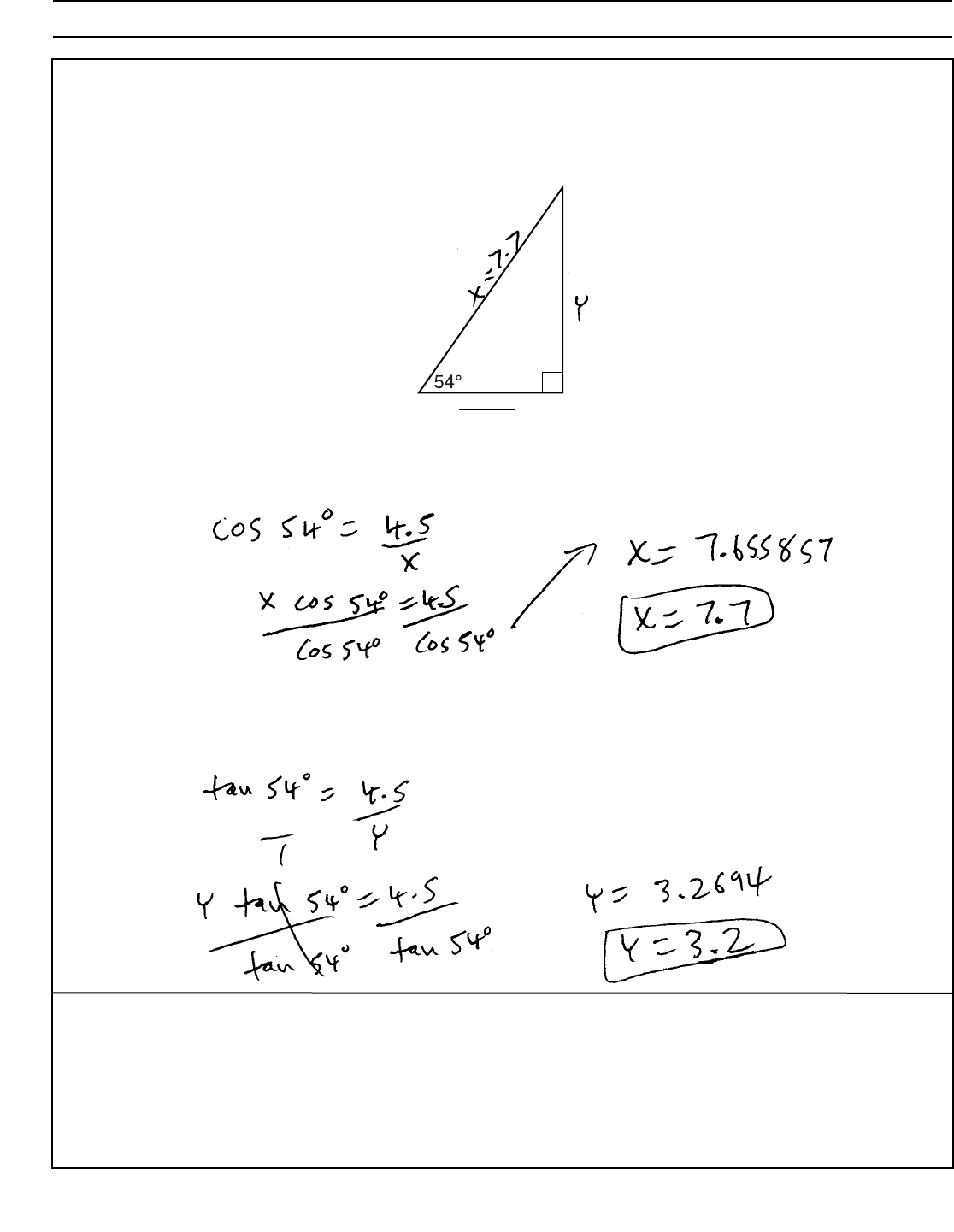
Geometry – Jan. ’18 [53]
Question 34
Score 2: The student found HI correctly, but wrote an incorrect trigonometric equation and
rounded incorrectly.
34 As shown in the diagram below, an island (I) is due north of a marina (M). A boat house (H) is
4.5 miles due west of the marina. From the boat house, the island is located at an angle of 54° from
the marina.
Determine and state, to the nearest tenth of a mile, the distance from the boat house (H) to the
island (I).
M
I
H 4.5 m
marina (M).
4.5 miles

Geometry – Jan. ’18 [54]
Question 34
Score 1: The student wrote a correct trigonometric equation to find HI, but no further correct
work was shown.
34 As shown in the diagram below, an island (I) is due north of a marina (M). A boat house (H) is
4.5 miles due west of the marina. From the boat house, the island is located at an angle of 54° from
the marina.
Determine and state, to the nearest tenth of a mile, the distance from the boat house (H) to the
island (I).
M
I
H 4.5 m
marina (M).
4.5 miles

Geometry – Jan. ’18 [55]
Question 34
Score 1: The student made two rounding errors and wrote an incorrect trigonometric equation
to find HI.
34 As shown in the diagram below, an island (I) is due north of a marina (M). A boat house (H) is
4.5 miles due west of the marina. From the boat house, the island is located at an angle of 54° from
the marina.
Determine and state, to the nearest tenth of a mile, the distance from the boat house (H) to the
island (I).
M
I
H 4.5 m
marina (M).
4.5 miles

Geometry – Jan. ’18 [56]
Question 34
Score 0: The student did not show enough correct relevant work to receive any credit.
34 As shown in the diagram below, an island (I) is due north of a marina (M). A boat house (H) is
4.5 miles due west of the marina. From the boat house, the island is located at an angle of 54° from
the marina.
Determine and state, to the nearest tenth of a mile, the distance from the boat house (H) to the
island (I).
M
I
H 4.5 m
marina (M).
4.5 miles

Geometry – Jan. ’18 [57]
Question 35
35 In the coordinate plane, the vertices of triangle PAT are P(⫺1,⫺6), A(⫺4,5), and T(5,⫺2). Prove
that PAT is an isosceles triangle. [The use of the set of axes on the next page is optional.]
State the coordinates of R so that quadrilateral PART is a parallelogram.
Question 35 is continued on the next page.
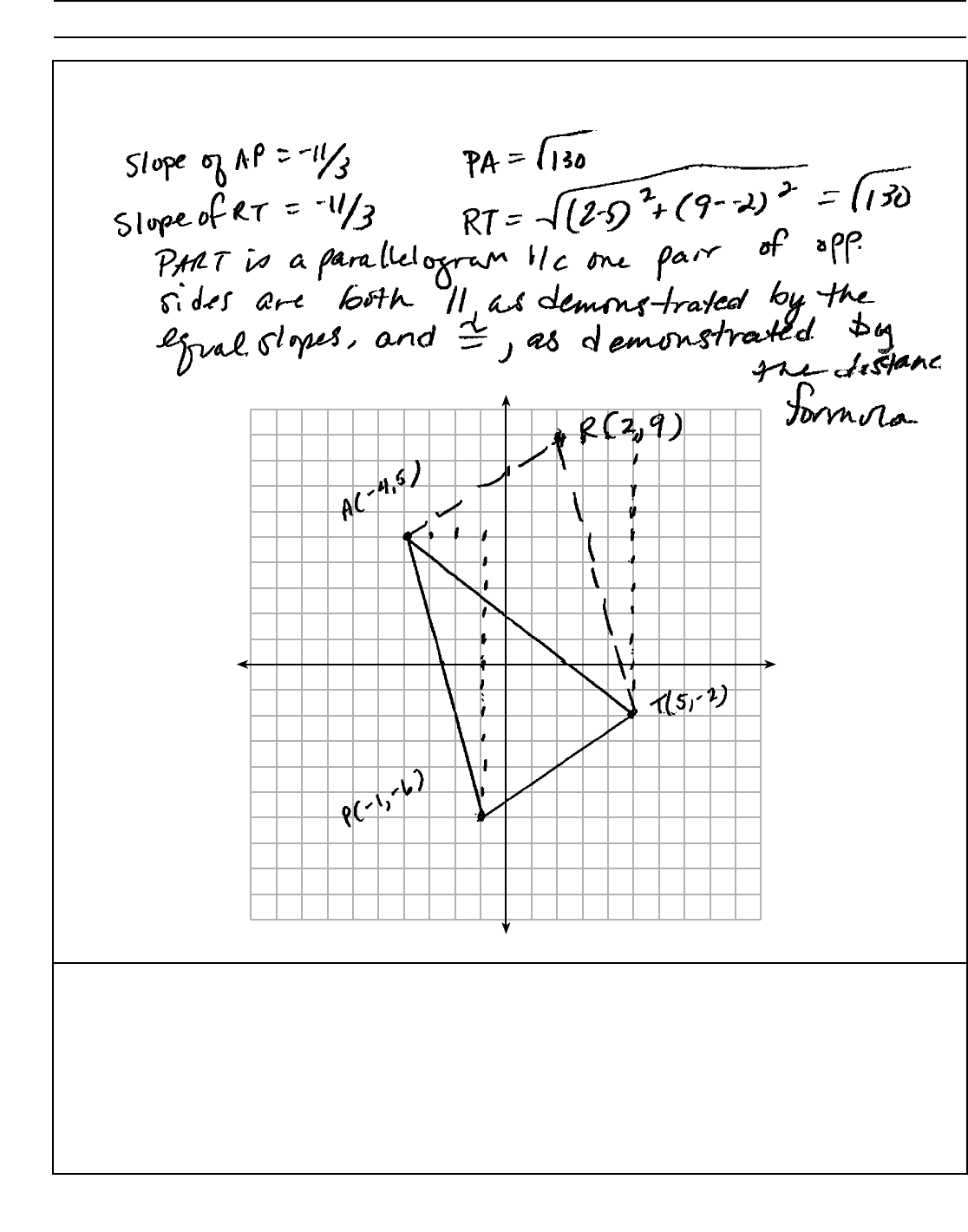
Geometry – Jan. ’18 [58]
Question 35
Score 6: The student gave a complete and correct response.
Prove that quadrilateral PART is a parallelogram.
y
x
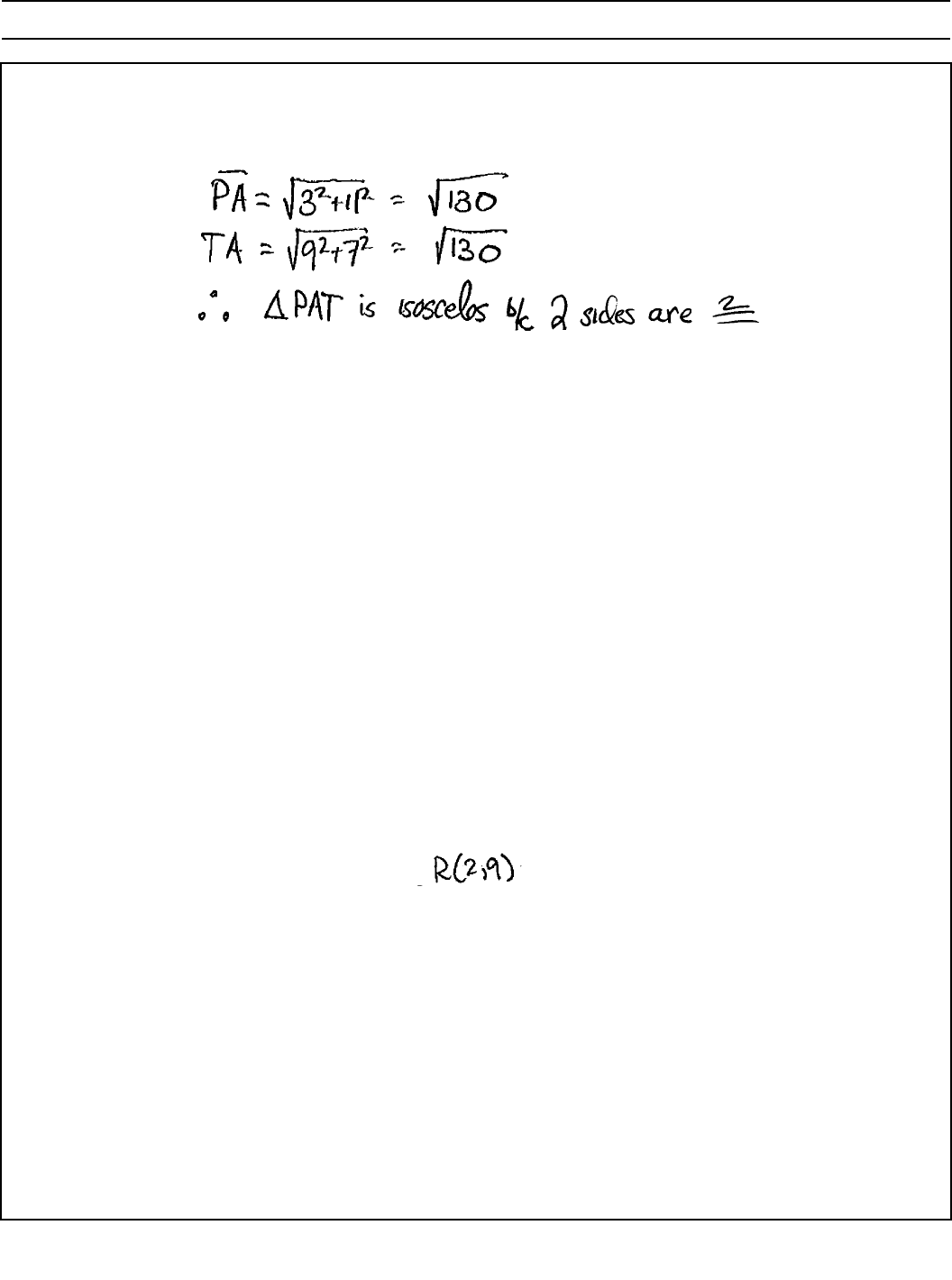
Geometry – Jan. ’18 [59]
Question 35
35 In the coordinate plane, the vertices of triangle PAT are P(⫺1,⫺6), A(⫺4,5), and T(5,⫺2). Prove
that PAT is an isosceles triangle. [The use of the set of axes on the next page is optional.]
State the coordinates of R so that quadrilateral PART is a parallelogram.
Question 35 is continued on the next page.

Geometry – Jan. ’18 [60]
Question 35
Score 5: The student wrote an incomplete conclusion when proving PART is a parallelogram.
Prove that quadrilateral PART is a parallelogram.
y
x

Geometry – Jan. ’18 [61]
Question 35
35 In the coordinate plane, the vertices of triangle PAT are P(⫺1,⫺6), A(⫺4,5), and T(5,⫺2). Prove
that PAT is an isosceles triangle. [The use of the set of axes on the next page is optional.]
State the coordinates of R so that quadrilateral PART is a parallelogram.
Question 35 is continued on the next page.

Geometry – Jan. ’18 [62]
Question 35
Score 5: The student did not connect the equal slopes to parallelism in proving PART as
a parallelogram, therefore the concluding statement is incomplete.
Prove that quadrilateral PART is a parallelogram.
y
x

Geometry – Jan. ’18 [63]
Question 35
35 In the coordinate plane, the vertices of triangle PAT are P(⫺1,⫺6), A(⫺4,5), and T(5,⫺2). Prove
that PAT is an isosceles triangle. [The use of the set of axes on the next page is optional.]
State the coordinates of R so that quadrilateral PART is a parallelogram.
Question 35 is continued on the next page.

Geometry – Jan. ’18 [64]
Question 35
Score 4: In proving PAT is isosceles, no conclusion was written. In proving PART as a parallelogram,
the student did not connect the equal slopes to parallelism.
Prove that quadrilateral PART is a parallelogram.
y
x
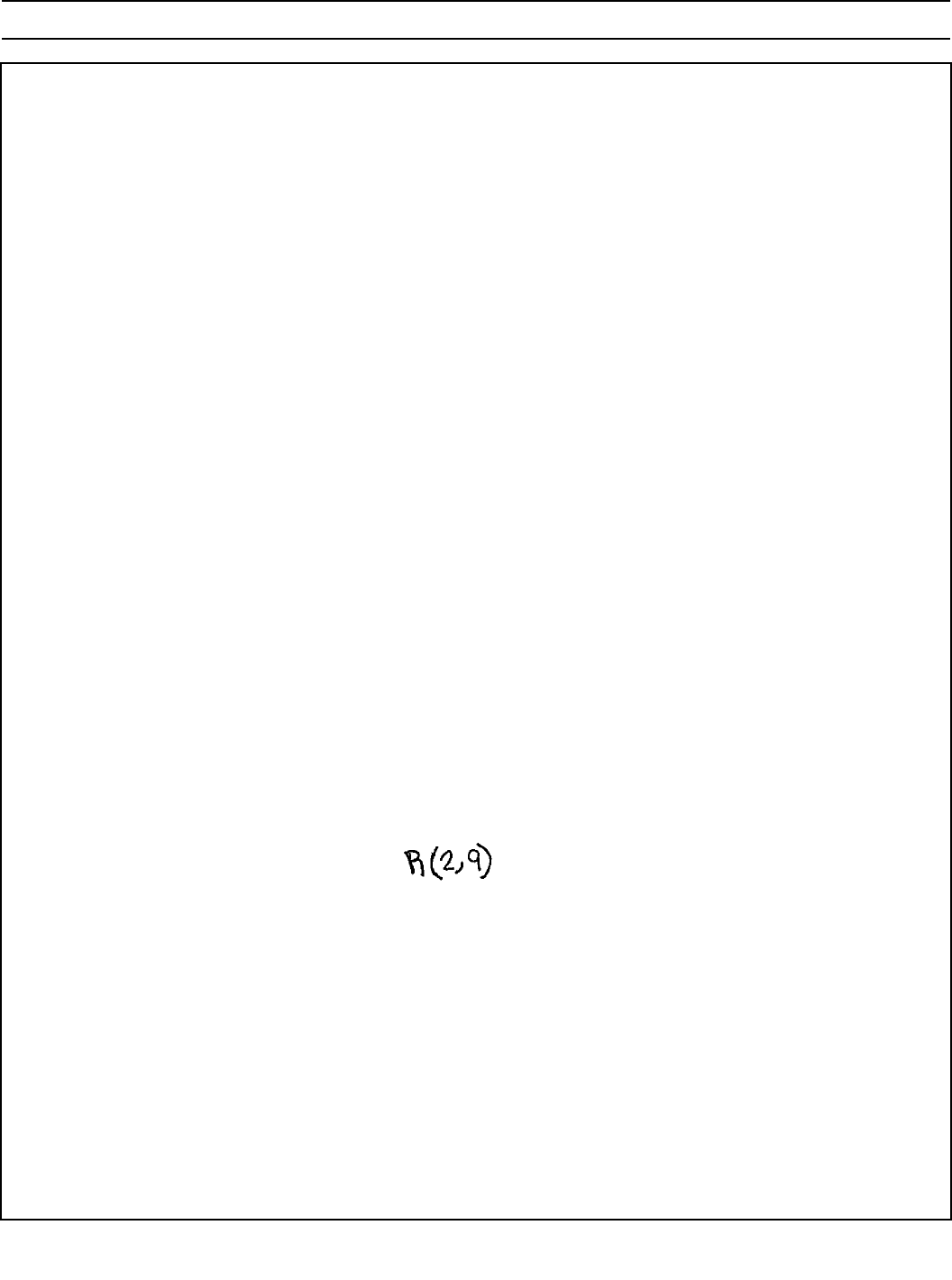
Geometry – Jan. ’18 [65]
Question 35
35 In the coordinate plane, the vertices of triangle PAT are P(⫺1,⫺6), A(⫺4,5), and T(5,⫺2). Prove
that PAT is an isosceles triangle. [The use of the set of axes on the next page is optional.]
State the coordinates of R so that quadrilateral PART is a parallelogram.
Question 35 is continued on the next page.

Geometry – Jan. ’18 [66]
Question 35
Score 3: The student did not prove PAT is an isosceles triangle. The student wrote an incomplete
statement in proving PART is a parallelogram (step 7).
Prove that quadrilateral PART is a parallelogram.
y
x

Geometry – Jan. ’18 [67]
Question 35
35 In the coordinate plane, the vertices of triangle PAT are P(⫺1,⫺6), A(⫺4,5), and T(5,⫺2). Prove
that PAT is an isosceles triangle. [The use of the set of axes on the next page is optional.]
State the coordinates of R so that quadrilateral PART is a parallelogram.
Question 35 is continued on the next page.

Geometry – Jan. ’18 [68]
Question 35
Score 3: The student correctly proved that PAT is isosceles and correctly identified point (2,9).
No further correct work was shown.
Prove that quadrilateral PART is a parallelogram.
y
x

Geometry – Jan. ’18 [69]
Question 35
35 In the coordinate plane, the vertices of triangle PAT are P(⫺1,⫺6), A(⫺4,5), and T(5,⫺2). Prove
that PAT is an isosceles triangle. [The use of the set of axes on the next page is optional.]
State the coordinates of R so that quadrilateral PART is a parallelogram.
Question 35 is continued on the next page.

Geometry – Jan. ’18 [70]
Question 35
Score 2: Isosceles triangle PAT was proven, but no further correct work was shown.
Prove that quadrilateral PART is a parallelogram.
y
x

Geometry – Jan. ’18 [71]
Question 35
35 In the coordinate plane, the vertices of triangle PAT are P(⫺1,⫺6), A(⫺4,5), and T(5,⫺2). Prove
that PAT is an isosceles triangle. [The use of the set of axes on the next page is optional.]
State the coordinates of R so that quadrilateral PART is a parallelogram.
Question 35 is continued on the next page.

Geometry – Jan. ’18 [72]
Question 35
Score 1: The student correctly found the lengths of and , but no further correct work was
shown. Point R was not written as coordinates.
AT
AP
Prove that quadrilateral PART is a parallelogram.
y
x

Geometry – Jan. ’18 [73]
Question 35
35 In the coordinate plane, the vertices of triangle PAT are P(⫺1,⫺6), A(⫺4,5), and T(5,⫺2). Prove
that PAT is an isosceles triangle. [The use of the set of axes on the next page is optional.]
State the coordinates of R so that quadrilateral PART is a parallelogram.
Question 35 is continued on the next page.

Geometry – Jan. ’18 [74]
Question 35
Score 1: The student found the correct coordinates of point R, but no further correct work was
shown.
Prove that quadrilateral PART is a parallelogram.
y
x

Geometry – Jan. ’18 [75]
Question 35
35 In the coordinate plane, the vertices of triangle PAT are P(⫺1,⫺6), A(⫺4,5), and T(5,⫺2). Prove
that PAT is an isosceles triangle. [The use of the set of axes on the next page is optional.]
State the coordinates of R so that quadrilateral PART is a parallelogram.
Question 35 is continued on the next page.

Geometry – Jan. ’18 [76]
Question 35
Score 0: The student had a completely incorrect response.
Prove that quadrilateral PART is a parallelogram.
y
x
